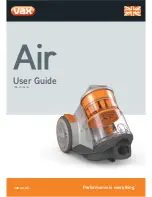
GB
GB
- 19 -
The equipment is to be used only for its prescri-
bed purpose. Any other use is deemed to be a
case of misuse. The user / operator and not the
manufacturer will be liable for any damage or inju-
ries of any kind caused as a result of this.
Please note that our equipment has not been de-
signed for use in commercial, trade or industrial
applications. Our warranty will be voided if the
machine is used in commercial, trade or industrial
businesses or for equivalent purposes.
4. Technical data
Mains voltage: ...................220-240 V ~ 50/60 Hz
Power consumption: ............................... 1600 W
Max. power consumption
Automatic socket-outlet: ......................... 1800 W
Max. total power consumption: ............... 3400 W
Max underpressure .....................230 hPa (mbar)
Dust class ........................................................ L
Sound pressure level LpA ..................... 74 dB(A)
Uncertainty KpA .................................... 2 dB (A)
Tank volume: ..................................................50 l
Max. filling capacity (water)
.........................37,5 l
Weight: ....................................... approx. 14.5 kg
5. Before starting the equipment
Warning!
Before you connect the equipment to the mains
supply make sure that the data on the rating plate
are identical to the mains data.
5.1 Assembling the equipment
Fitting the wheels (Fig. 4-11/13)
Place a split pin for fitting the wheels (31) through
the appropriate hole in the axle (33) and fit a
washer (30), a wheel (13) and a washer to the
axle (33) (Fig. 5-6). Now slide the axle (33)
through the guides provided for it on the undersi-
de of the tank (10) (Fig. 7). Fit a washer and the
second wheel (13) to the empty end of the axle
(33) and secure it with the other washer (30) and
the split pin (31) (Fig. 8-10). Push the covers (32)
on to the outside of the wheels (13) so that the
detents engage on the covers (32) for the wheel
(13). (Fig. 11)
Fitting the castors (Fig. 12a-12b)
Fit the castors (12) into the appropriate moun-
tings on the underside of the tank (10). Secure
the castors with the supplied screws as shown in
Fig. 12b.
Fitting the push bar (Fig. 13)
Insert the push bar (35) into the provided push
bar brackets (36) until you feel them latch into
position.
Fitting the appliance head (Fig. 14-15/5)
The appliance head (5) is fastened to the contai-
ner (10) by the locking hook (18). To remove the
appliance head (5), open the locking hook (18)
and remove the appliance head (5). When fitting
the appliance head (5), make sure that the lo-
cking hook (18) locks into place correctly.
5.2 Fitting the filter
Notice!
Never use the wet and dry vacuum cleaner wit-
hout a filter.
Check that the filter is securely fitted at all times.
Fitting the foam filter (Fig. 16/25)
For wet vacuuming, slip the supplied foam filter
(25) over the filter basket (Fig. 2/20). The pleated
filter (Fig.3/24) already fitted upon delivery is not
suitable for wet vacuuming.
Fitting the pleated filter (Fig. 17/24)
For dry-vacuuming, slip the pleated filter (Fig.
3/24) over the filter basket (Fig. 2/20). The pleated
filter (Fig. 3/24) is suitable for dry-vacuuming only.
Fitting the coarse filter (Fig. 19a)
The coarse filter (16) can be used for suctioning
large amounts of fine dust (with or without a dirt
collector bag).
Important!
The coarse filter is not suitable for
wet vacuuming!
Place the coarse filter (16) on the rim of the con
-
tainer (10) as shown in Fig. 19a. Ensure that the
coarse filter is fitted completely on the rim of the
container.
Fitting the sealing ring (Fig. 19b)
The sealing ring (37) must fitted for wet suctioning
and whenever the coarse filter is not used.
Place the sealing ring (37) on the rim of the con-
tainer (10) as shown in Fig. 19b. Ensure that the
sealing ring is fitted completely on the rim of the
container.
Anl_TE_VC_2350_SACL_SPK13.indb 19
Anl_TE_VC_2350_SACL_SPK13.indb 19
26.01.2021 13:52:58
26.01.2021 13:52:58
















































